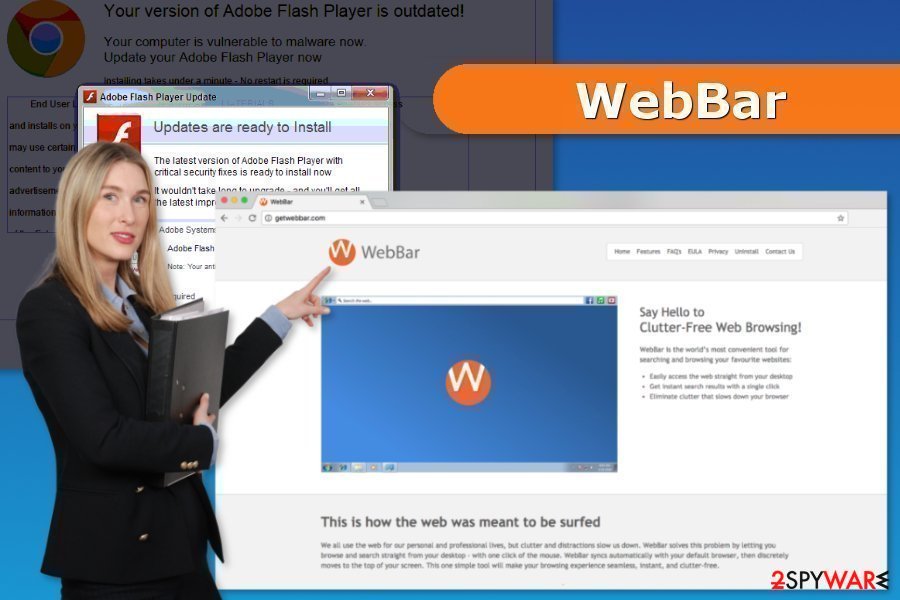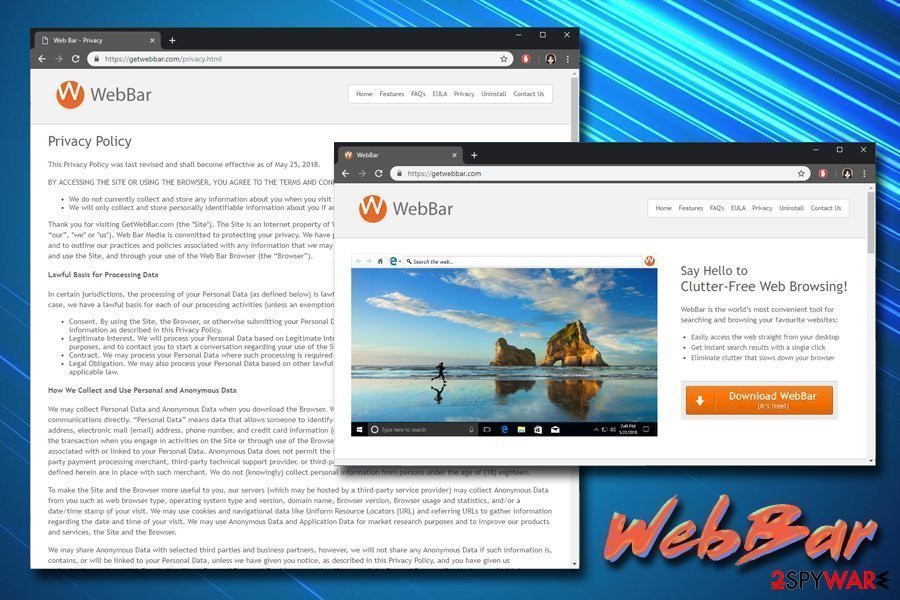WebBar (Free Guide) - 2021 update
WebBar Removal Guide
What is WebBar?
Web Bar is a deceptive PUP that adds a search bar at top of your screen

Web Bar is a potentially unwanted program that has been infecting users' computers since 2015. Typically, it spreads attached to freeware or shareware installers. Once established, the PUP modifies settings of Google Chrome, Internet Explorer, Mozilla Firefox, Safari, or another browser and sets a search bar at the top of the Windows desktop.
Users are then forced to browse through the WebBar search engine which has mostly been working on generating income to its developers. Unfortunately, the end-user might suffer from continual redirects to suspicious sites, sponsored links, pop-up ads, altered search results which consequently may induce malware infection or even cause data leakage. However, there is no way to disable the search bar at the top of your screen, unless you remove it from the system entirely.
| Name | Web Bar |
| Type | Browser hijacker/PUP |
| Developer | Web Bar Media |
| Distribution | Software bundling, the official website |
| Symptoms | The search bar is added at top of screen, suspicious redirects, pop-up ads, and similar unwanted commercial content disturb web browsing sessions |
| Main dangers | Malware infection, data leak |
| Elimination | Check our manual guide below or use anti-virus software |
| Optimization | To clean your device and recover from PUP damage, use FortectIntego |
Security experts do not recommend installing the app. However, this potentially unwanted program (PUP)[1] might sneak into the system without asking direct permission. Developers apply the bundling technique to achieve this goal.
Once inside the system, the redirect virus might make system modifications and alter the browser’s settings in order to control your browsing sessions. As a result, you can find a huge search bar at top of the desktop and be forced to use it each time you start your browsing. However, the results that are provided cannot be trusted as they are typically filled with commercial links into search results or trigger redirects to suspicious third-party sites.
Moreover, the hijacker might display targeted advertisements that are labeled as Web Bar ads during browsing. Usually, these ads are based on your browsing history, because the PUP might collect information about users, such as:
- IP address,
- technical information about the browser or operating system,
- search queries,
- recently visited websites and pages,
- other browsing-related information.
Furthermore, the developers of the app also may collect personal information (which is quite alarming), as stated in their Privacy Policy:
We may collect Personal Data and Anonymous Data when you download the Browser. We may also collect Personal Data when you send us information or communications directly. “Personal Data” means data that allows someone to identify or contact you including, without limitation, your name, physical address, electronic mail (email) address, phone number, and credit card information (collectively, your “Personal Data”) for the purposes of recording the transaction when you engage in activities on the Site or through use of the Browser.

The biggest dangers are related to PUP's redirect problems. The potentially unwanted application might trigger sudden redirects or display ads[2] that lead to infected or phishing[3] websites. Experts from Viruset.no[4] claim that having this program installed keeps you closer to malware attacks.
That's why we think that you should remove Web Bar search bar from your computer. For that, you can use the manual removal method or automatic removal. If you don't want to download anything to your machine, you can follow the guide below and remove this program manually.
However, we think that you should scan your computer with anti-spyware just to be sure that PUP removal is completed successfully. After that, we suggest you install FortectIntego and perform a full scan. This will ensure that the elimination of virus damage caused by the PUP.
Free programs help to spread browser hijacker
In most cases, redirect starts interrupting PC users out of nowhere because this program is capable of infiltrating computers with the help of freeware and shareware. For avoiding an unexpected appearance of this program, you have to start monitoring the installation of the freeware because there are lots of applications that are filled with suspicious components trying to infiltrate computers unnoticed.
After you decide to install a free application, make sure you check what is said on its Privacy Policy[5] and End User's License Agreement.[6] Also, you should select the Custom or Advanced installation method to see what components are added to your freeware. These methods will also help you opt-out of unwanted components that may be trying to enter your computer behind your back.

Eliminate the virus correctly
Web Bar removal requires uninstalling the program from the Control Panel and lookup for the suspicious add-on in each of browser installed on your PC. The guide below will help you to get rid of the search bar from the top screen and all other components of this PUP.
However, you can also run a full system scan with reputable security software to remove the PUP automatically. This method is perfect for those who are not advanced computer users or simply want to save some time for more pleasant activities.
As soon as you get rid of the hijacker from your machine, you should rest each of the installed browsers. This will ensure that any settings that might have been modified by a hijacker are reset. For that, follow the instructions below.
You may remove virus damage with a help of FortectIntego. SpyHunter 5Combo Cleaner and Malwarebytes are recommended to detect potentially unwanted programs and viruses with all their files and registry entries that are related to them.
Getting rid of WebBar. Follow these steps
Uninstall from Windows
Go to Control Panel and access Uninstall a Program. Here look up for WebBar and uninstall it together with other unknown applications. Then reset all web browsers that are installed on your PC.
Instructions for Windows 10/8 machines:
- Enter Control Panel into Windows search box and hit Enter or click on the search result.
- Under Programs, select Uninstall a program.

- From the list, find the entry of the suspicious program.
- Right-click on the application and select Uninstall.
- If User Account Control shows up, click Yes.
- Wait till uninstallation process is complete and click OK.

If you are Windows 7/XP user, proceed with the following instructions:
- Click on Windows Start > Control Panel located on the right pane (if you are Windows XP user, click on Add/Remove Programs).
- In Control Panel, select Programs > Uninstall a program.

- Pick the unwanted application by clicking on it once.
- At the top, click Uninstall/Change.
- In the confirmation prompt, pick Yes.
- Click OK once the removal process is finished.
Delete from macOS
Remove items from Applications folder:
- From the menu bar, select Go > Applications.
- In the Applications folder, look for all related entries.
- Click on the app and drag it to Trash (or right-click and pick Move to Trash)

To fully remove an unwanted app, you need to access Application Support, LaunchAgents, and LaunchDaemons folders and delete relevant files:
- Select Go > Go to Folder.
- Enter /Library/Application Support and click Go or press Enter.
- In the Application Support folder, look for any dubious entries and then delete them.
- Now enter /Library/LaunchAgents and /Library/LaunchDaemons folders the same way and terminate all the related .plist files.

Remove from Microsoft Edge
These instructions will help you to eliminate hijacker-related entries from the Microsoft Edge:
Delete unwanted extensions from MS Edge:
- Select Menu (three horizontal dots at the top-right of the browser window) and pick Extensions.
- From the list, pick the extension and click on the Gear icon.
- Click on Uninstall at the bottom.

Clear cookies and other browser data:
- Click on the Menu (three horizontal dots at the top-right of the browser window) and select Privacy & security.
- Under Clear browsing data, pick Choose what to clear.
- Select everything (apart from passwords, although you might want to include Media licenses as well, if applicable) and click on Clear.

Restore new tab and homepage settings:
- Click the menu icon and choose Settings.
- Then find On startup section.
- Click Disable if you found any suspicious domain.
Reset MS Edge if the above steps did not work:
- Press on Ctrl + Shift + Esc to open Task Manager.
- Click on More details arrow at the bottom of the window.
- Select Details tab.
- Now scroll down and locate every entry with Microsoft Edge name in it. Right-click on each of them and select End Task to stop MS Edge from running.

If this solution failed to help you, you need to use an advanced Edge reset method. Note that you need to backup your data before proceeding.
- Find the following folder on your computer: C:\\Users\\%username%\\AppData\\Local\\Packages\\Microsoft.MicrosoftEdge_8wekyb3d8bbwe.
- Press Ctrl + A on your keyboard to select all folders.
- Right-click on them and pick Delete

- Now right-click on the Start button and pick Windows PowerShell (Admin).
- When the new window opens, copy and paste the following command, and then press Enter:
Get-AppXPackage -AllUsers -Name Microsoft.MicrosoftEdge | Foreach {Add-AppxPackage -DisableDevelopmentMode -Register “$($_.InstallLocation)\\AppXManifest.xml” -Verbose

Instructions for Chromium-based Edge
Delete extensions from MS Edge (Chromium):
- Open Edge and click select Settings > Extensions.
- Delete unwanted extensions by clicking Remove.

Clear cache and site data:
- Click on Menu and go to Settings.
- Select Privacy, search and services.
- Under Clear browsing data, pick Choose what to clear.
- Under Time range, pick All time.
- Select Clear now.

Reset Chromium-based MS Edge:
- Click on Menu and select Settings.
- On the left side, pick Reset settings.
- Select Restore settings to their default values.
- Confirm with Reset.

Remove from Mozilla Firefox (FF)
Check Firefox extensions and get rid of questionable ones:
Remove dangerous extensions:
- Open Mozilla Firefox browser and click on the Menu (three horizontal lines at the top-right of the window).
- Select Add-ons.
- In here, select unwanted plugin and click Remove.

Reset the homepage:
- Click three horizontal lines at the top right corner to open the menu.
- Choose Options.
- Under Home options, enter your preferred site that will open every time you newly open the Mozilla Firefox.
Clear cookies and site data:
- Click Menu and pick Settings.
- Go to Privacy & Security section.
- Scroll down to locate Cookies and Site Data.
- Click on Clear Data…
- Select Cookies and Site Data, as well as Cached Web Content and press Clear.

Reset Mozilla Firefox
If clearing the browser as explained above did not help, reset Mozilla Firefox:
- Open Mozilla Firefox browser and click the Menu.
- Go to Help and then choose Troubleshooting Information.

- Under Give Firefox a tune up section, click on Refresh Firefox…
- Once the pop-up shows up, confirm the action by pressing on Refresh Firefox.

Remove from Google Chrome
Delete malicious extensions from Google Chrome:
- Open Google Chrome, click on the Menu (three vertical dots at the top-right corner) and select More tools > Extensions.
- In the newly opened window, you will see all the installed extensions. Uninstall all the suspicious plugins that might be related to the unwanted program by clicking Remove.

Clear cache and web data from Chrome:
- Click on Menu and pick Settings.
- Under Privacy and security, select Clear browsing data.
- Select Browsing history, Cookies and other site data, as well as Cached images and files.
- Click Clear data.

Change your homepage:
- Click menu and choose Settings.
- Look for a suspicious site in the On startup section.
- Click on Open a specific or set of pages and click on three dots to find the Remove option.
Reset Google Chrome:
If the previous methods did not help you, reset Google Chrome to eliminate all the unwanted components:
- Click on Menu and select Settings.
- In the Settings, scroll down and click Advanced.
- Scroll down and locate Reset and clean up section.
- Now click Restore settings to their original defaults.
- Confirm with Reset settings.

Delete from Safari
Remove unwanted extensions from Safari:
- Click Safari > Preferences…
- In the new window, pick Extensions.
- Select the unwanted extension and select Uninstall.

Clear cookies and other website data from Safari:
- Click Safari > Clear History…
- From the drop-down menu under Clear, pick all history.
- Confirm with Clear History.

Reset Safari if the above-mentioned steps did not help you:
- Click Safari > Preferences…
- Go to Advanced tab.
- Tick the Show Develop menu in menu bar.
- From the menu bar, click Develop, and then select Empty Caches.

After uninstalling this potentially unwanted program (PUP) and fixing each of your web browsers, we recommend you to scan your PC system with a reputable anti-spyware. This will help you to get rid of WebBar registry traces and will also identify related parasites or possible malware infections on your computer. For that you can use our top-rated malware remover: FortectIntego, SpyHunter 5Combo Cleaner or Malwarebytes.
How to prevent from getting browser hijacker
Choose a proper web browser and improve your safety with a VPN tool
Online spying has got momentum in recent years and people are getting more and more interested in how to protect their privacy online. One of the basic means to add a layer of security – choose the most private and secure web browser. Although web browsers can't grant full privacy protection and security, some of them are much better at sandboxing, HTTPS upgrading, active content blocking, tracking blocking, phishing protection, and similar privacy-oriented features. However, if you want true anonymity, we suggest you employ a powerful Private Internet Access VPN – it can encrypt all the traffic that comes and goes out of your computer, preventing tracking completely.
Lost your files? Use data recovery software
While some files located on any computer are replaceable or useless, others can be extremely valuable. Family photos, work documents, school projects – these are types of files that we don't want to lose. Unfortunately, there are many ways how unexpected data loss can occur: power cuts, Blue Screen of Death errors, hardware failures, crypto-malware attack, or even accidental deletion.
To ensure that all the files remain intact, you should prepare regular data backups. You can choose cloud-based or physical copies you could restore from later in case of a disaster. If your backups were lost as well or you never bothered to prepare any, Data Recovery Pro can be your only hope to retrieve your invaluable files.
- ^ Vangie Beal. PUP - potentially unwanted program. Webopedia. Online tech dictionary.
- ^ Malvertising: When Online Ads Attack. Trend Micro. Enterprise Cyber Security Solutions.
- ^ Geraldine Strawbridge. 5 Ways to Identify a Phishing Website. MetaCompliance. Simulated Phishing, eLearning, GDPR consultants.
- ^ Viruset. Viruset. Norwegian spyware news.
- ^ Privacy Policy. Techopedia. IT dictionary.
- ^ End-user license agreement. Wikipedia. The free encyclopedia.
